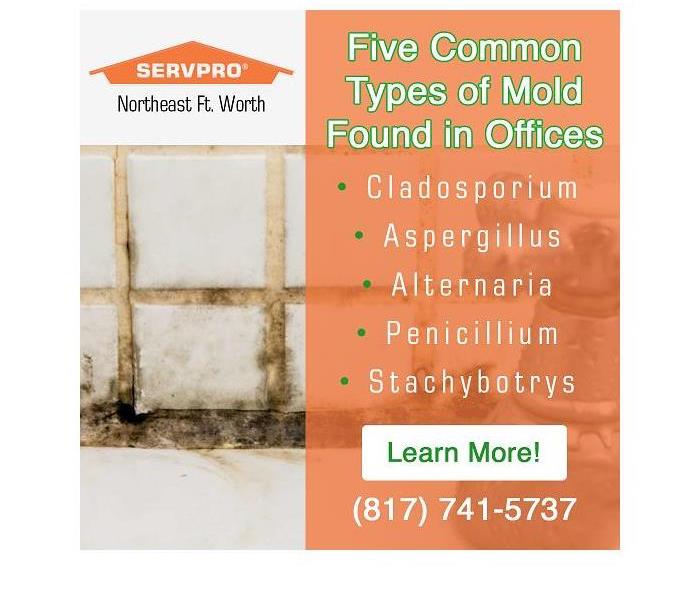What Types of Mold Can Be Found in Commercial Facilities?
9/23/2021 (Permalink)
Blog Summary: Several different types of mold can take hold in an office building or other commercial environment. When business owners need mold mitigation services, they can turn to the team of professional technicians at SERVPRO of Northeast Ft. Worth.
SERVPRO of Northeast Ft. Worth understands the importance of keeping an office building and other commercial settings clean, fresh, and safe from a mold infestation, which can accompany water damage to the facility. Technicians are highly trained in commercial property damage restoration and cleaning techniques. SERVPRO of Northeast Ft. Worth follows the highest IICRC standards, so customers can trust the damage restoration and cleaning team to handle any situation, including a mold infestation in an office building or other commercial setting.
Repairs, maintenance, and janitorial services usually involve issues that are easily detectable — a spill in the hallway, a stain on the carpet, a squeaky door. However, mold is often a hidden issue. Mold proliferation is a growing concern and can affect health, worker productivity, and the customer experience. The goal of mold mitigation is to keep the facility in the best condition for tenants, employees, clients, customers, and anyone else that might visit the office building. The facility must be functional, clean, fresh, and healthy.
Five Common Types of Mold Found in Offices
Texture, color, or shape are not necessarily key indicators of the exact species of mold. Some mold types are visually indistinguishable from other types of molds, and in many instances, professional testing is required to determine which mold is present. A particular surface condition can host many different mold species.
- Cladosporium
This hearty mold can thrive in a variety of conditions and on a wide range of surfaces. Some molds prefer damper and warmer environments, but this mold can take hold almost anywhere in the temperate environment of a climate-controlled office complex.
Common locations to keep an eye out for Cladosporium include food storage areas such as the office kitchen, as well as the gasket on the doors to the refrigerator and freezer. Mirrors, windows, ceramic tile, and other non-porous surfaces where condensation can occur are a favorite residence for this mold. This mold is unsightly and makes a negative impression on clients, customers, and tenants.
- Aspergillus
Aspergillus, a robust mold strain that thrives indoors, feeds on cardboard, artwork, shelving, leather furniture, pressed wood products, and the cloth bindings of books. The spores from this mold may cause health effects. Mold can also impact the health of pets. There is a growing trend of bringing pets into the workplace, and an office complex may host support animals or service dogs.
- Alternaria
This outdoor mold travels into the office on people and pets. An open office window is an invitation to this mold strain to pay a visit to the office team. The warmth and moisture of summer are this mold’s preferred environment. This mold may be found growing on cloth upholstery.
- Penicillium
Most people think of mold as being black or brown. According to the Centers for Disease Control, color is not an indicator of toxicity. Molds may be black, brown, green, yellow, blue, and even pink or orange! Penicillium, a toxic mold that causes food spoilage, may be yellow, blue, or green in color. Drapes, cabinets, and ceiling tiles are surfaces this mold favors. Drywall that has been moistened from a water intrusion fosters the growth of this mold. While Penicillium is the source of the medical marvel penicillin, the mold can have health effects if left to spread in an office building.
- Stachybotrys
Known as “black mold,” Stachybotrys enjoys fibrous surfaces such as paper and wood. This moisture-loving mold is a slow-growing toxic beast that can cause health effects long before it is discovered and identified.
Mitigating Mold in an Office Building
When mold is discovered, mitigation should begin immediately. Common causes of mold include inadequate ventilation, condensation, melting ice dams, or water damage from flooding or leaky plumbing. When water intrusion is identified, the business owner should secure the services of a water damage restoration company to remediate the damage and prevent a widespread mold infestation.
For more information about mold mitigation, water damage restoration, and other restoration and cleaning services in Halcolm City, TX, contact the SERVPRO of Northeast Ft. Worth, TX, by phone at (817) 741-5737. The team can also be contacted by email at office@SERVPROnortheastftworth.com





 24/7 Emergency Service
24/7 Emergency Service
